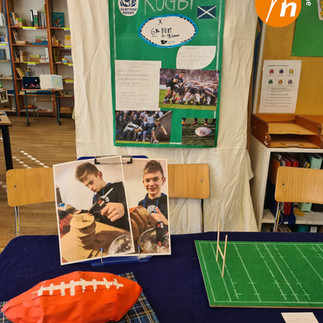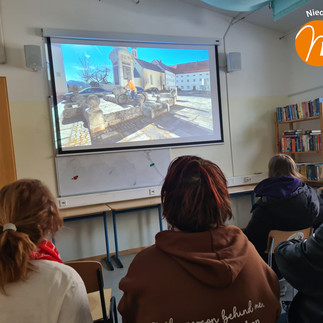Abtauchen in die englische Sprache
- andreageisslitz
- 24. Feb.
- 4 Min. Lesezeit

Unsere Mittelstufe (5. und 6. Klasse) ist in der Zeit zwischen den Weihnachts- und den Faschingsferien komplett in die englische Sprache abgetaucht. Immer Mittwochs und Donnerstags ging es für die Kids mit Schuluniform in die „Scottish International School“ für „Total Immersion“ Englisch Unterricht. Zum Abschluss erarbeiteten alle Schüler*innen ein selbst gewähltes Thema mit Bezug zu Schottland in englischer Sprache. Mit großem Stolz präsentierten sie dann den schriftlichen und praktischen Teil ihrer Arbeiten.
Phoedra, Lehrerin in der Mittelstufe, erklärt uns, was es genau mit der Scottish International School auf sich hat und was unserer Schüler*innen bei dem Projekt lernen – natürlich auf Englisch 😉!

How do your pupils learn English?
We believe pupils learn English best by being able to engage with topics in which they are interested. The more choice and agency the students have, the greater their interest in the project they are working on will be, and the more time, energy and creativity they will be willing to invest. Intrinsic motivation at its best!
Why do you as teachers focus on "total immersion" i.e. complete immersion in the language?
We don't solely focus on this method; in fact, we only offer this project once every two years. Project Based Learning (PBL) at this level, especially in a foreign language, is quite simply extremely time consuming and strenuous for both pupils and instructors. It requires a lot of planning, preparation, the necessary space and instructors, who get along well enough to coordinate successfully. For the pupils it is equally strenuous, as it requires them to continuously compute what they are hearing, seeing and reading, without a break. That is hard work and requires rest in between.
How did you come up with the idea of implementing total immersion through a Scottish International School?
This is the third time we have implemented this unit here in Niederseeon. The first time was in the school year 2018/2019 with my then 6th grade class in the MS2. I was inspired by a magnificent educational training held by Birgitta Berger and Leni Dam on autonomous learning in foreign language instruction. It was not possible for my class to travel to an English-speaking country, so I decided to bring the country to them. That year my students chose Australia, and I created a pretend International School for them to attend. Once I get started, I am all in, and thus this unit was born. When Beate joined the Mittelstufe, we brought the PBL project back to life together. Two years ago, we co-taught it for the first time and this year is our second run. In two years we will discover a new English-speaking country, maybe Canada or Ireland or South Africa. The possibilities are vast.
Class President Elections
Campaign posters
How does a lesson at the Scottish International School work?
During the eight-week immersion unit on Scotland our students are part of a complete learning experience. They wear school uniforms and badges, learn the school rules, contribute new vocabulary to the Scottish Word Wall, campaign for and elect their class presidents and vice presidents, study the target country in the target language, choose independent topics and research these. In the seventh week the pupils display their findings to the rest of the school with work pieces, displays and written handouts or posters. In the final week we reflect on the process, and each pupil or group of pupils presents their "peaks and valleys" (Höhen und Tiefen) in front of their class.
What do the pupils learn?
During this unit, the pupils focused on variouls cultural aspects of Scottish life. They all received basic introductory information on the social structure, geography, and the school system. Beate spent 10 months teaching at a school in Scotland, so she is our expert on all things Scottish. Our pupils read and listened to poetry by the famous Scottish poet Robert Burns and worked with material to learn more about the tradition of Burns Night in Scotland. Beyond that, pupils chose aspects of Scottish culture that most interested them and researched these topics independently to prepare for their exhibition. But most importantly, pupils gain self-confidence in the target language, both spoken and written. They experience the language as well as the target country as completely as is possible outside of the country itself. And they realize what they are capable of, when both motivation and expectations are high. This unit requires pupils to grow and develop resilience, while working as independently as possible and being provided proper guidance and assistance when necessary.
Does this mean that learning English is possible without cramming vocabulary and grammar?
In a perfect and immersed environment, yes. However, no school, even our wonderful school here in Niederseeon, is perfect. Without the correct conditions and proper framework for immersion, studying grammar and vocabulary remains necessary when learning a target language outside of the country where it is spoken daily. HOW we study and practice grammar and vocabulary, however, doesn't have to be torture! It can be fun, creative and interactive. Montessori materials and methods, as well as a well-prepared environment make that possible, even under imperfect conditions.
The project presentations of the Scottish Cultural Exhibit at the end of the term:



























































Comments